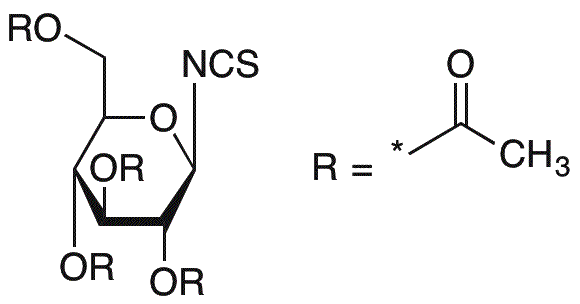2,3,4,6-Tetra-O-acetyl-b-D-glucopyranosyl isothiocyanate is widely utilized in research focused on:
- Chiral Derivatization: This compound is essential in the field of chiral chromatography, helping researchers separate and analyze enantiomers effectively, which is crucial in pharmaceuticals for drug development.
- Biochemical Research: It serves as a valuable reagent in synthesizing glycosyl isothiocyanates, which can be used to study carbohydrate-protein interactions, aiding in the understanding of biological processes.
- Drug Development: The compound is used in the modification of drug candidates to enhance their solubility and bioavailability, making it a key player in the pharmaceutical industry.
- Food Industry: It can be applied in food chemistry to analyze glycosylated compounds, contributing to the development of healthier food products with improved nutritional profiles.
- Environmental Science: This chemical is utilized in the detection of certain pollutants, helping researchers develop methods for monitoring and mitigating environmental contamination.
General Information
Properties
Safety and Regulations
Applications
2,3,4,6-Tetra-O-acetyl-b-D-glucopyranosyl isothiocyanate is widely utilized in research focused on:
- Chiral Derivatization: This compound is essential in the field of chiral chromatography, helping researchers separate and analyze enantiomers effectively, which is crucial in pharmaceuticals for drug development.
- Biochemical Research: It serves as a valuable reagent in synthesizing glycosyl isothiocyanates, which can be used to study carbohydrate-protein interactions, aiding in the understanding of biological processes.
- Drug Development: The compound is used in the modification of drug candidates to enhance their solubility and bioavailability, making it a key player in the pharmaceutical industry.
- Food Industry: It can be applied in food chemistry to analyze glycosylated compounds, contributing to the development of healthier food products with improved nutritional profiles.
- Environmental Science: This chemical is utilized in the detection of certain pollutants, helping researchers develop methods for monitoring and mitigating environmental contamination.
Documents
Safety Data Sheets (SDS)
The SDS provides comprehensive safety information on handling, storage, and disposal of the product.
Product Specification (PS)
The PS provides a comprehensive breakdown of the product’s properties, including chemical composition, physical state, purity, and storage requirements. It also details acceptable quality ranges and the product's intended applications.
Certificates of Analysis (COA)
Search for Certificates of Analysis (COA) by entering the products Lot Number. Lot and Batch Numbers can be found on a product’s label following the words ‘Lot’ or ‘Batch’.
Numéro de catalogue
Numéro de lot/série
Certificates Of Origin (COO)
This COO confirms the country where the product was manufactured, and also details the materials and components used in it and whether it is derived from natural, synthetic, or other specific sources. This certificate may be required for customs, trade, and regulatory compliance.
Numéro de catalogue
Numéro de lot/série
Safety Data Sheets (SDS)
The SDS provides comprehensive safety information on handling, storage, and disposal of the product.
DownloadProduct Specification (PS)
The PS provides a comprehensive breakdown of the product’s properties, including chemical composition, physical state, purity, and storage requirements. It also details acceptable quality ranges and the product's intended applications.
DownloadCertificates of Analysis (COA)
Search for Certificates of Analysis (COA) by entering the products Lot Number. Lot and Batch Numbers can be found on a product’s label following the words ‘Lot’ or ‘Batch’.
Numéro de catalogue
Numéro de lot/série
Certificates Of Origin (COO)
This COO confirms the country where the product was manufactured, and also details the materials and components used in it and whether it is derived from natural, synthetic, or other specific sources. This certificate may be required for customs, trade, and regulatory compliance.


